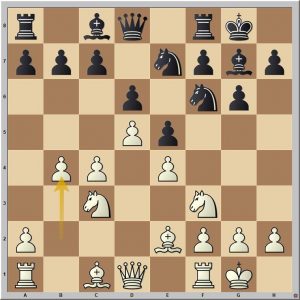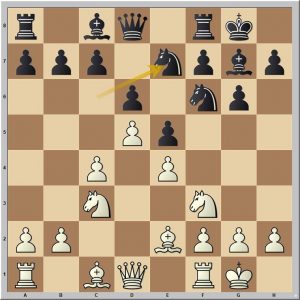During the last months I worked on a course on the Bayonet Attack for CHESSABLE. It will be available, when the videos will have been produced.
The Bayonet Attack arises after the moves 1.d4 Nf6 2.c4 g6 3.Nc3 Bg7 4.e4 d6 5.Nf3 0-0 6.Be2 e5 7.0-0 Nc6 8.d5 Ne7 9.b4!

I consider it White’s best approach and it lets the Mar del Plata-Variation appear in a very bad light. Black might be better off to go for one of the smaller lines, avoiding the position after 7…Nc6 altogether. Most of them, however, also lead to a clear advantage for White. At the moment, I am working on a follow-up course, which is dealing with all of these many sidelines.
I will now present you the introduction of the course on the Bayonet Attack in two parts.
Part I
1.d4 Nf6 2.c4 g6
If you want to evaluate a given position or come up with the right plan, it’s very helpful to think in terms of “the main theme” or “the dominating theme”. That said, not in every position there is one single prominent theme. Often there are two or three of them, like in a good piece of music or literature. In our present variation, however, the theme of “space” or, more specifically, “White’s space advantage” is towering above everything else. Hence, it might be useful that we put our “space glasses” on, right from the beginning. Looking through them, Black’s second move, as common as it is, already appears to be remarkable.
Instead of securing his fair share of the center by playing 2…e6, with the intention to continue with 3…d5 (Queen’s Gambit Declined), 3…Bb4 (Nimzoindian) or 3…b6 (Queen’s Indian), Black concedes the center and spatial control to his opponent. This strategy can be considered doubtful, as spatial control or spatial advantage are widely acknowledged values in chess. By definition, the term “doubtful” doesn’t relate to a well-founded evaluation, but concerns a mere provisional perception. It’s a working hypothesis, waiting to be verified or falsified. In fact, I consider it a good methodical approach to assign everything which contradicts the Classical School of Chess, founded by the likes of Steinitz and Tarrasch, to the list of suspects. Now, the burden of proof should be on the modern or hypermodern opening to demonstrate its soundness through concrete variations. This is, because according to my personal experience, the majority of these suspects has failed the test of time.
Coming back to the current position, Black surely deserves the chance to convince us from the quality of his approach. Theoretically, he could get away with his contempt for space, if he manages to prove that White’s space advantage is not only an asset but also a liability, which can be exploited by potential counter attacks. In that case we would see a trade-off and a dynamic equilibrium as a result.
3.Nc3 Bg7

The view on this move depends on the evaluation of the King’s Indian Defense and the Grünfeld Indian Defence. If both openings were bad, it would leave this move unaffected. In that case, a question mark would have to be attached to 2…g6. If the Grünfeld was okay and the King’s Indian bad, this move would deserve a question mark. Let’s start with the Grünfeld. As I am far from being an expert, I was looking at current games between 2700+ players. My observations didn’t reveal any particular problems for Black, so I assume that the Grünfeld Indian Defense is 100% viable. Actually, this was already suspected by the contemporaries of Ernst Grünfeld, when this revolutionary concept was introduced in the 1920s. For the average club player, the only problem comes from the practical side. The comparatively high degree of tactical piece interaction makes a lot of concrete knowledge mandatory. Apart from that, there is also quite an amount of different pawn structures to digest. By contrast, the closed nature of the King’s Indian allows its user to rely much more on his knowledge of general patterns. The KID is easier to play, but what about its objective quality?
From my current point of perception, I consider the King’s Indian inferior to the Grünfeld Indian Defense. First of all, I write these lines after I performed an intensive analysis on the Bayonet Attack, which made me an expert of this topic. And yes, why not giving you the good news right here, at the beginning!? In the Bayonet Attack, I failed to find a single line, where Black was able to get away with +=. All lines end with +/- or better. If we assume that this observation of mine is right, we can conclude that the move 7…Nc6, which is the mainline of the Classical Variation, is bad for Black. Now, everything depends on the many sidelines Black has at his disposal. I also performed some analyses there and my current idea is that most of the sidelines are clearly better for White. However, one or two of them might be good enough for granting Black a disadvantage of only 0.5 pawn units, which would be translated to +=. In my opinion, the Grünfeld is superior, because Black has more space available, which allows his pieces to become more active and strongly improves the chances for a successful counter attack.
Of course, I am aware of the fact that the Kings Indian is also used by top grandmasters once in a while. The times, however, where world class players exclusively banked on the King’s Indian are long gone. Already in the 1990s we could see Kasparov, Shirov, Gelfand, Judith Polgar and others say goodbye to the KID. They were tired of that constant uphill fight. Today’s 2700-players are extremely versatile and command a huge arsenal of weapons. They have to dodge engine-based preparation and hence keep their lines in a state of permanent rotation. Feel free to assume that they pick their spots and apply the King’s Indian only when they don’t have to expect the most critical reaction.
Should a tournament player stop adhering to the King’s Indian because of my negative opinion? No, definitively not. The KID has some interesting features. It is fun to play and allows Black to aim at the full point. If it serves you well, than stick to it. If your opponents lack the strength to transmit the objective advantage they have after your academic mistake on move 3 into a good middlegame position, there is nothing for you to worry about. However, when you are climbing the hierarchies and feel the sea becoming rougher, than it might be a good time for a reappraisal.
Yes, no question mark for 3…Bg7. Even if I carry this question mark in my mind, I am not entitled to make it visible. There are still too many unknowns. Every one has to draw his own conclusion at this early point in the game.
4.e4 d6 5.Nf3
The Classical Variation is not the only line Black has to fear, but it surely is one of the most principled ones.
5…0-0 6.Be2 e5
Black has the option to resort to sidelines on move 5, 6 and 7. Those on move 5 normally transpose, so I left them unmentioned.
Here on move 6, Black could deviate from the main path with 6…Bg4. After 7.Be3 Nfd7 Black intends to attack the point d5 with 8…c5, 8…e5 or 8…Nc6, followed by 9…e5. According to my analyses, which might be published in a follow-up course on the the KID sidelines, White ends up having a clear advantage.
The same applies for 6…c5, after which the easiest way for White is to enter a Maroczy-setup with 7.0-0 cxd4 8.Nxd4.
7-0-0 Nc6?!
With more than 51.000 games in ChessBase’s Online Database at the time of writing, this move, leading to the Mar del Plata variation after 8.d5 Ne7, can be clearly considered the main continuation. But not all that shines is gold (or a “sea of silver” for that matter). The most popular alternatives are 7…Nbd7, 7…Na6, 7…exd4 and 7…c6, adding up to some 34.000 games. White’s position ranges between slightly and clearly better, depending on the specific variation. As it appears to me now, a clear advantage is the much more frequent result, however.
8.d5 Ne7

With hindsight, it is hard to believe that this position was able to attract so many black players. Most of them, including the author back in the early 1990s, did so without much thinking, I guess. Following the cool guys, such as Tal, Fischer, Kasparov, Nunn or Shirov felt good and natural. However, this choice starts to look doubtful, even if it is only submitted to a sober abstract analysis. Let’s sum up all actual or potential problems Black has to face:
1. Space
White enjoys a comfortable space advantage. You might argue that space is more a means to an end, a rather relative phenomenon, which receives its value in relations to piece activity and integrity (presence or absence of weaknesses). This “relativity of space advantage” is an interesting topic and will be discussed in the model game Berg-Wahls, Hamburg 2002. In that case, conceding space to the opponent was tolerable, but this doesn’t hold true for the King’s Indian Defense.
2. Integrity
Sometimes, having space advantage can be a liability, in case your position is overextended and possesses weak pawns or weak squares. In the current position, I can only see one weakness in White’s camp, which is the square d4. As this is difficult to exploit, we don’t have to worry too much about it. Overextension often occurs, after mass exchanges took place, when a strongly reduced army has to defend a vast area. Such a position would be prone to be penetrated. But thank God, all pieces are still on board, defending our precious space. Another cause of concern could be a lack of development, which would make us vulnerable to an early counter attack. Some of you will know the game Letelier-Fischer, Leipzig 1960. For that reason, we are not playing the Four Pawns Attack (5.f4), but the Classical Variation. We are neither space-greedy, nor are we too timid. We grab space in moderation, just what it takes to perform a nice long-term squeeze.
3. Piece Activity
Space is only useful, if it makes our pieces thrive or helps to restrict the opponent’s forces. Obviously, White’s pieces can move freely. Even the “bad” light-squared bishop will find good prospects after the standard advance c4-c5 or after the exchange of the pawn e4. For Black the situation looks far less pleasant, though. Let’s go piece by piece:
a) Bg7
The “King’s Indian bishop” is very important for the safety of the king. It can also become active, in case White plays f2-f4 or after White’s e-pawn is exchanged and the advance e5-e4 made possible. But as we will generally try to avoid both situations, Black’s bishop will be condemned to stare at its fellow e-pawn, most of the time.
b) Ne7
This knight is really a miserable piece. Its activation through …Kh8 and the maneuver …Ne7-g8-f6 takes a lot of time and the method …f7-f5, …fxe4, …Nf5 creates us a monster knight on e4.
c) Bc8
This bishop enjoys a free view, but has nowhere to go. On d7 it is not very effective and often prevents the queen from protecting the d-pawn, which becomes weak after White’s c4-c5-advance. Normally, it has to stay on c8, impeding the connection between the major pieces.
d) Nf6
The knight blocks the f-pawn and its unblocking costs at least one extra tempo. We as White don’t face this problem, as we had the foresight to play 2.c4 before developing our queen’s knight. If the black knight moves to e8 or d7, it will have to retreat to f6 in most cases. This round trip amounts to the consumption of two full tempi. It might be enticing to move the knight more actively to h5 and then further to f4. However it turns out, that this ambitious maneuver comes with more problems than joy, as documented in the section 9.b4 Nh5.
4. King Safety
Some black protagonist could argue, that it is the queenside where White expands and the kingside where Black attacks. White might win tons of material over there, while in the meantime his king is getting mated. This indeed could be true, but only if White complies. The way we will fight the King’s Indian, makes Black’s king suffer more than ours. After the move f7-f5 it won’t have any pawn cover anymore along the 7th rank and once the central pawns disintegrate, both diagonals, a2-g8 and a1-h8 will become pretty draughty for his majesty. In many evaluations at the end of my lines Black’s bad king safety will be one of the important factors. By contrast, our king will enjoy the highest degree of protection, with the pawns staying on h2, g2 and f2.
The question, how to best punish Black for violating the laws of chess finally leads us to…..
To be continued
